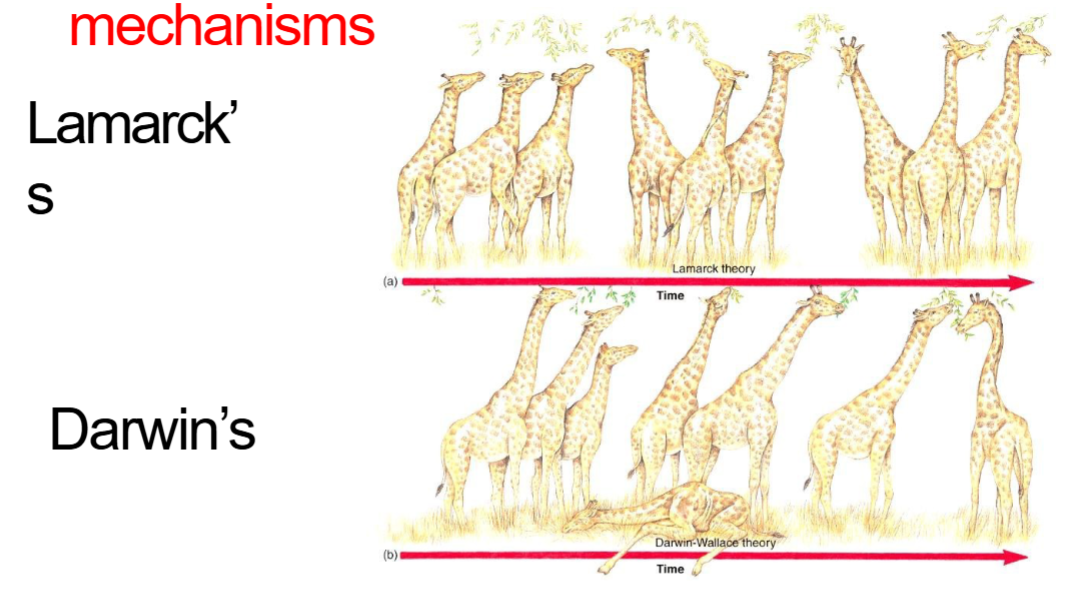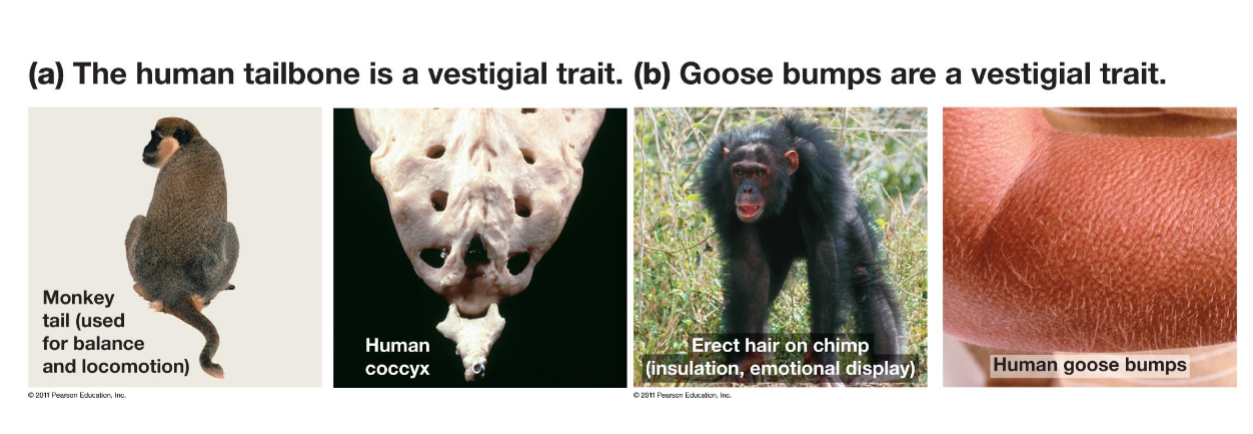Biology Review Unit 5
1/50
There's no tags or description
Looks like no tags are added yet.
Name | Mastery | Learn | Test | Matching | Spaced |
|---|
No study sessions yet.
51 Terms
What are the 5 characteristics of life?
1) Organisms are made of cells
(STRUCTURE & FUNCTION)
2) Organisms are capable of replication
(INFORMATION FLOW, EXCHANGE AND STORAGE)
3) Organisms have mechanisms to store information
(INFORMATION FLOW, EXCHANGE AND STORAGE)
4) Organisms have a mechanism to acquire & transform energy
(PATHWAYS & TRANSFORMATION OF ENERGY &
MATTER)
5) Organisms have a capacity to adapt/change
(EVOLUTION)
What is the modern cell theory?
All organisms are made of cells and all cells come from pre-existing cells
Scientist Spotlight: Al-Jahiz
Abū ʿUthman ʿAmr ibn Baḥr
al-Kinānī al-Baṣrī
• 776 - 868
• He was reported to haveat
written over two hundred
works
• Wrote “Book of Animals”
• Grouped animals
• Transformation of animals
• Effect of environmental
factors
Who were the 3 people that developed the thought of Evolution, and what did each one contribute?
1) Plato (428-348 BC)
• Typological
Thinking
• Special
Creation
• Unchanging
2) Aristotle (384-322 BC)
• Great Chain of
Being
• Hierarchy
• Unchanging
3) Jean Baptiste de Lamarck (1744-1829)
• Species change over
time...
• Up the great chain of
being
• Mechanism:
Inheritance of
acquired
characteristics
What did Darwin and Wallace contribution to Evolution?
Populations evolve overtime and are linked together through common ancestry; not structured into a hierarchy.
Population definition
Population: a group of individuals of the same species
that are living in the same place at the same time
than can and do breed
Differing views of evolutionary mechanisms between Lamark and Darwin (giraffes)
Lamarck : giraffes lengthened necks by
stretching
• Mechanism: acquired characteristic passed to offspring.
• Darwin: long-neck giraffes out compete short
necks
• Short neck giraffes died or don’t breed

Theory of Natural Selection?
1) Common ancestry: Species today
arose from preexisting species.
2) Descent with Modification: Species
characteristics can change over time
3) Natural Selection: The process whereby organisms better adapted to their environment tend to survive and produce more offspring.
How old is the Earth?
Earth is about 4.6 billion years old
Where and when did the earliest signs of life appear?
Earliest signs of life appears in rocks about
3.4-3.8 billion years ago
What are the 3 ways in how species change throughout time?
1) Extinction
2) Transitional Forms
3) Vestigial Traits
What is Extinction?
Termination of an organism meaning reproduction is no longer able to happen.
Evolution also supports natural selection by creating opportunities for new species to emerge and thrive. When a species faces extinction, it leaves behind ecological niches that become available to other organisms. This vacancy creates evolutionary opportunities for surviving species to diversify and adapt to fill these roles, often leading to adaptive radiation events where one lineage rapidly diversifies into many new species.
Who was Baron Georges Curvier and what did he discover about extinction?
Baron Georges Cuvier (1769-1832):
1) groundbreaking paleontologist who compared living organisms with fossils (among other accomplishments)
2) Realized two extinct species (Irish Elk and Helicoprion) were too large to escape notice, and too unique to be an existing species.
How do species change through transitional forms?
Living species “succeed” fossil species in the same region. → refers to the idea that as species evolve, they leave behind their remains, and that new species are reconstructed through the fossil remains.
Vestigial Traits definition
Vestigial Traits – reduced or incompletely developed structure that has no or
reduced function but is like functioning organ or structured in closely related species.
Two examples of vestigial traits?

Describe the process of speciation
The formation of new species due to reproductive isolation or environmental changes.
Speciation occurs when populations of a species become reproductively isolated, preventing gene flow and leading to genetic divergence over time.
Homology definition
“Study of likeness” or similarities between organisms that is due to inheritance from a common ancestor.
What are the 3 different types of homology?
1) Structural Homology
2) Developmental Homology
3) Genetic Homology
What is structural homology?
1) refers to similarities in anatomical structures
2) also knows as comparative methodology: compare physical structures in different organisms to identify common ancestry.
3) this similarity can be observed in the bones, organs, and genes that evolved from a common ancestor.
What is developmental homology?
1) similarities in developmental patterns; studying embryonic development patterns to illustrate evolutionary patterns.
2) embryos of many vertebrae species develop in similar ways.
3) all vertebrates go through a stage in which they have four limb buds, a tail, and a series of gills.
What is genetic homology?
1) similarities in DNA sequences
2) a concept in genetics that describes the relationship between genes or DNA sequences that are similar because they have been inherited from a common ancestor.
What does evolution favor?
evolution favors traits that enhance survival and reproductive success, which may include simple traits that are more efficient.
What is biological fitness?
Biological fitness is the ability of an individual to produce surviving offspring.
How is fitness determined?
by observing the traits of an organism that are more advantageous in regard to responding to the demands of the environment.
What is an individual?
A single organism
What is a population?
A group of individuals that are the same species at the same time at the same place.
Natural selection acts on the ___, while evolution occurs on the ____ level.
individuals, population
1) individuals with traits that enhance survival and reproduction pass these traits to offspring, leading to gradual changes in populations overtime.
What is Darwin’s four postulates?
1) Variation exists among individual organisms that make up populations.
2) Some of the trait differences are heritable
3) Survival and reproductive success are highly variable. (many more offspring are produced than can possibly survive meaning offspring has to compete for resources for survival; not random)
4) The subset of individuals that survive best and produce the most offspring is not a random sample of the population.
In modern biology we condense Darwin’s four postulates into a simple sentence:
Evolution occurs by natural selection when heritable variation leads to differential reproductive success.
Directional Selection
1) Favors one extreme phenotype over others, shifting the population's traits in one direction.
2) Selective pressures favor individuals with traits at one end of the phenotypic spectrum, favoring the favored phenotype. overtime, the traits that are more advantageous become more common, while the less advantageous diminish in frequency.
Stabilizing Selection
1) Favors intermediate phenotypes, reducing variation in a trait.
2) natural selection is more likely to favor the average or most common trait within a population, because the intermediate phenotype is most likely to be fit for that current environment.
3) Overtime this can result in a population with reduced genetic diversity as the selection process removes the more severe phenotypes.
Disruptive Selection
1) Favors extreme phenotypes at both ends of the spectrum, potentially leading to speciation.
2) can lead to speciation by creating a scenario were populations become increasingly adapted to different environments which can cause barriers to arise, ultimately resulting in the emergence of new species.
Balancing selection
1) No single allele has a distinct advantage
2) Maintains genetic variation
3) One type favors rare alleles (frequency-dependent selection)
Sexual Selection
Selection based on traits that enhance mating success rather than survival.
Genetic Drift definition
Random changes in allele frequencies in a small population due to chance.
key point: genetic drift is random with respect to fitness.
What are some examples of how genetic drift can lead to significant changes in a small population?
1) In the founder effect, a small group of individuals breaks away from a larger population to establish a new population. Because this new population is formed from a limited number of individuals, the allele frequencies in the new population may differ significantly from those in the original population.
2) The bottleneck effect occurs when a population experiences a dramatic reduction in size due to environmental events (like natural disasters) or human activities (such as habitat destruction). This reduction can lead to a loss of genetic diversity, as only a small number of individuals contribute to the gene pool of the surviving population. The alleles present in the surviving individuals may not represent the original population's genetic diversity, leading to significant changes in allele frequencies.
Gene Flow definition
The transfer of alleles or genes from one population to another.
1) Occurs when individuals migrate between populations and interbreed, they bring different genetic material, which can enhance the overall genetic variation.
2) causes allele frequencies to be more alike between the two populations
Natural Selection definition
Differential survival and reproduction of individuals based on advantageous traits.
Mutation definition
A change in DNA that can create new alleles in a population.
1) They introduce genetic variation, which is essential for a population's adaptability to changing environments.
2) This variation can lead to new phenotypes, some of which may confer advantages in survival and reproduction.
3) Random with respect to fitness; usually deleterious or neutral
4) Happens “slowly”, except for organisms with short generation times
What are the 3 ways mutations can happen?
1) point mutation: a single or small number of base pairs changed in DNA
2) chromosome-level mutation: change in the number of structures of chromosomes
3) lateral gene transfer; movement of genes from one species to another
Sexual Selection definition
A form of natural selection where individuals with certain traits are more likely to attract mates.
1) Cause competition for mates
2) Changes frequency of alleles and increases fitness
What are Darwin’s contributions to the ideas of sexual selection?
concluded that male peacock tails must be adaptive by attracting mates and increasing reproductive success.
Nonrandom mating
Occurs when there is interbreeding or mate choice leading to changes in genotypes in a population but not allele frequency.
Why is interbreeding harmful?
Interbreeding leads to a loss of fitness overtime
Increased homozygosity: Inbreeding increases the likelihood of offspring inheriting two copies of the same harmful recessive allele, leading to inbreeding depression.
Reduced genetic diversity: The loss of genetic diversity within a population can reduce its ability to adapt to new environmental challenges, making it more susceptible to extinction.
Intersexual selection
a form of sexual selection where one sex chooses mates of the opposite sex based on specific traits.
Intrasexual selection
competition between members of the same sex and drives traits that are useful for direct combat
What is Sexual Selection based on?
Bateman-Trivers Hypothesis
What is the pattern, process, and prediction of the Bateman-Trivers Hypothesis?
Pattern: males generally benefit more from multiple matings than females do, leading to greater sexual selection pressure on males to compete for mates.
Process: based on how much or how little a male or female invests in their offspring which determines how picky or non-picky they are with mating.
Predictions: any allele that increases a male’s attractiveness to females or success in male-to-male competition should rapidly increase in the population.
What does sexual selection lead to?
Sexual dimorphism
Sexual dimorphism
the differences in appearance between males and females of the same species, which can include variations in color, structure, size, to attract mates.